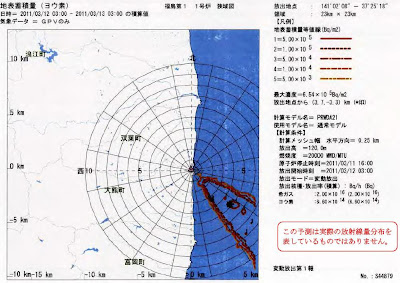(UPDATE) The earliest simulation was done at 4:00PM on March 11, assuming the leak of radioactive materials started at 4:00PM. (To see the simulation, go to the bottom of the post.)
---------------------------------------------
Now, after more than 50 days and after so much contamination of soil, water, air and ocean with radioactive iodine, cesium, strontium, plutonium, americium, curium, among other yet to be disclosed nuclides that have exposed the residents in Japan to heightened internal and external radiations, the Japanese government simply dumps the SPEEDI simulation data on the Ministry of Education's website.
What is, really, the point of telling us now? To say... what? They're sorry that they didn't tell you about the simulation when the radioactive materials were coming at 10,000 terabecquerels/hour and they knew it but were afraid people would freak out? I suppose the people in the administration and in the government would rather have a significant increase in cancer and other illnesses several decades down the line, because by that time they may be no longer in the government or no longer in this world.
The SPEEDI simulation data is here (in Japanese only):
http://www.mext.go.jp/a_menu/saigaijohou/syousai/1305747.htm
The earliest simulation that has been disclosed at the site is the simulation done on March 12 for the period from 3:00AM March 12 to 3:00AM March 13. The simulation assumed the accident of the Reactor 1. At 2:48AM on March 12, the pressure inside the Pressure Vessel of the Reactor 1 rose significantly, so whoever was in charge of SPEEDI did conduct a simulation assuming the Reactor 1 would blow. Looking at the simulation, it is clear that they assumed the wind direction to be offshore (west by northwest), and most of the radioactive materials would blow over the Pacific Ocean.

However, by the next simulation for 10:00AM to 8:00PM on March 12, the prevailing wind direction forecast shifted over time from northwest to east by southeast to south, resulting in the simulation that forecasts wide dispersion of radioactive iodine inland. The simulation chart below is the internal radiation exposure at the thyroid gland of a 1-year old by inhaling radioactive iodine:

After the Reactor 1 blew up, they even created the simulation for wider area, which shows they predicted the rapid expansion of the radioactive materials well north of Minami-Soma City and reaching Soma City (0ver 40 kilometers away from Fukushima I Nuke Plant), on a prevailing strong wind from the south. This is the simulation chart for the air radiation level, from 6:00PM to 8:00PM on March 12:

Prompt disclosure of such simulations could have made a huge difference. If the initial simulation when the pressure got high in the Reactor 1 of Fukushima I Nuke Plant had been disclosed, then the people in the immediate vicinity of the plant could have evacuated in a more orderly way instead of in a panic after the Reactor 1 blew up.
Professor Toshiso Kosako, who quit the job as the PM's special advisor in protest of the government response to the Fukushima I accident, said in his resignation statement that there was another program called WSPEEDI, which can cover much wider area ("several thousand kilometers", according to Professor Kosako). WSPEEDI can probably cover the entire Japan (except for outlying islands).
The Japanese government is still sitting on WSPEEDI simulations, if any exists as Professor Kosako says.
--------------------------------------
THE EARLIEST SIMULATION DONE WAS AT 4:00PM ON MARCH 11, and that simulation is posted at the Nuclear Safety Agency's site, not at Ministry of Education site. It assumes a minor accident (because they only forecast noble gas to spread) at the Reactor 1. The simulation chart is the air radiation level from 4:00 PM to 5:00PM on March 11:








 Tokyo Time
Tokyo Time
![[Most Recent Quotes from www.kitco.com]](http://www.kitconet.com/charts/metals/gold/t24_au_en_usoz_2.gif)


